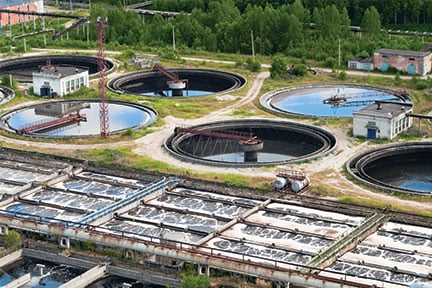Comprehending Wastewater Treatment Processes and Their Environmental Influence
The complexities of wastewater treatment processes play a pivotal role in mitigating ecological obstacles linked with water air pollution. Each phase, from preliminary to advanced therapies, is made to resolve certain pollutants, eventually protecting both public health and marine ecosystems.
Review of Wastewater Therapy
Exactly how is wastewater transformed right into a risk-free resource for the setting? Wastewater therapy is an important process developed to remove impurities from utilized water, thus safeguarding public wellness and securing environments. This process starts with the collection of wastewater from household, industrial, and commercial resources, which is then routed to treatment centers.
At these facilities, numerous physical, chemical, and organic approaches are employed to deal with the wastewater. Subsequently, biological therapies, such as triggered sludge procedures, utilize microbes to damage down natural issue.
The dealt with effluent can be safely released into all-natural water bodies or reused for watering and industrial functions, advertising resource conservation. Additionally, the therapy procedure produces biosolids, which can be repurposed as fertilizers or dirt modifications, better improving sustainability.
Phases of Therapy Procedures
The wastewater therapy procedure usually contains three main phases: initial, key, and secondary treatment. Each stage offers a distinctive duty in reducing the contaminant tons and making certain the effluent meets ecological criteria before discharge.
The primary treatment phase concentrates on the physical splitting up of put on hold solids from the wastewater. Via sedimentation, much heavier bits clear up at the base of sedimentation storage tanks, developing sludge, while lighter materials, such as oils and greases, float to the surface and are skimmed. This procedure substantially minimizes the organic and inorganic load in the wastewater.
Second therapy is a biological process aimed at further lowering the focus of organic matter. This phase is crucial for accomplishing the required biochemical oxygen demand (FIGURE) reduction, ultimately leading to cleaner effluent all set for discharge or further therapy.

Advanced Therapy Technologies
Following the additional treatment processes, progressed treatment innovations play a vital function in more improving the top quality of treated wastewater. These innovations are made to eliminate recurring contaminants that are not successfully removed during main and second treatments, making sure the effluent meets strict governing standards.
Among the extensively made use of advanced therapy approaches are membrane filtering, reverse osmosis, and progressed oxidation procedures. Membrane filtration, including microfiltration and ultrafiltration, works in separating fine bits, virus, and colloids from the water (Wastewater). Reverse osmosis utilizes semi-permeable membranes to eliminate liquified solids, causing top quality water appropriate for numerous applications
Advanced oxidation procedures (AOPs) employ strong oxidants to break down natural toxins, consisting of drugs and personal care products that are resistant to traditional therapy. These approaches enhance the biodegradability of complex compounds, facilitating their removal.
One more substantial innovation is the usage of organic nutrient elimination processes, which particularly target nitrogen and phosphorus, stopping eutrophication in getting water bodies. Generally, innovative therapy innovations are necessary for attaining greater levels of purification, promoting water reuse, and safeguarding public health while resolving the obstacles related to wastewater monitoring.
Ecological Benefits of Treatment
Countless ecological advantages occur from effective wastewater treatment procedures that contribute to ecosystem health and sustainability. Primarily, these procedures dramatically minimize the release of unsafe toxins into natural water bodies, which aids preserve aquatic communities. By removing impurities such as heavy metals, nutrients, and virus, treated wastewater mitigates the threat of waterborne illness and promotes biodiversity in aquatic environments.
In addition, wastewater therapy other facilities usually utilize innovative innovations that enable water recycling and reuse. This technique not only preserves freshwater sources however additionally lowers the demand on all-natural water supplies. Boosted nutrient removal from wastewater can likewise avoid eutrophication, a procedure that results in algal blossoms and subsequent oxygen deficiency in aquatic systems.
Furthermore, effective therapy procedures can lessen greenhouse gas exhausts, especially methane and laughing gas, which are typically launched throughout without treatment wastewater decay. By recording and making use of biogas from anaerobic digesters, centers can convert waste right into renewable resource, therefore contributing to a decrease in nonrenewable fuel source dependency.
Difficulties and Future Fads
While the environmental benefits of wastewater treatment are clear, numerous obstacles persist that impede ideal end results in this area. One major issue is aging facilities, which often results in ineffectiveness and raised operational costs - Wastewater. Numerous treatment plants were created years earlier, and their capacities do not align with modern demands, which include stricter regulative requirements and higher volumes of wastewater because of urbanization

Looking ahead, there is a growing focus on resource recuperation and round economy concepts within wastewater treatment. Innovations such as anaerobic food digestion, which can create biogas, and progressed filtration innovations are gaining grip. These methods not just enhance therapy effectiveness yet likewise advertise sustainability.
Eventually, addressing these obstacles requires cooperation among stakeholders, financial investment in technology, and a dedication to ongoing research study. By welcoming these patterns, the wastewater therapy Resources industry can progress to meet the needs of a transforming atmosphere and culture.
Conclusion
Finally, wastewater therapy processes play an essential role my latest blog post in improving ecological quality and public wellness. The multi-stage therapy framework, combined with innovative technologies, successfully minimizes pollution and promotes lasting water management. By dealing with recurring contaminants and reducing vitamins and mineral drainage, these processes contribute to the conservation of aquatic environments and the decrease of greenhouse gas exhausts. Continued improvements and adjustments in therapy approaches will be vital for getting rid of arising challenges and guaranteeing the sustainability of natural resources (Wastewater).